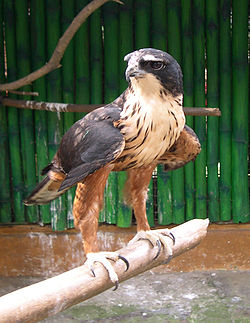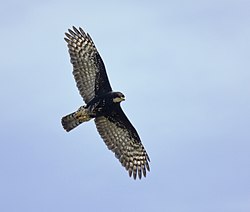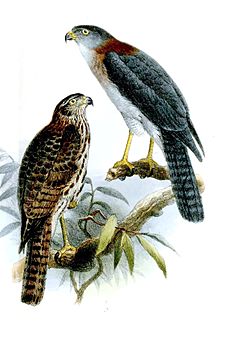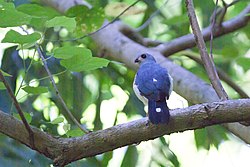| Common name | Binomial name | Population | Status | Trend | Notes | Image |
|---|
| Cuban kite | Chondrohierax wilsonii | 50-249 [4] | CR [4] |  [4] [4] | | |
| California condor | Gymnogyps californianus | 93 [5] | CR [5] |  [5] [5] | There are currently 201 adults in the wild that are old enough to breed. The IUCN counts re-introduced individuals separately. [5] |  |
| Malagasy harrier | Circus macrosceles | 100-499 [6] | EN [6] |  [6] [6] | |  |
| Philippine eagle | Pithecophaga jefferyi | 128-924 [7] | CR [7] |  [7] [7] | |  |
| Great Nicobar serpent-eagle | Spilornis klossi | 150-370 [8] | EN [8] | ? [8] | Best estimate of population is 150-180 mature individuals. [8] |  |
| Réunion marsh-harrier (Réunion harrier) | Circus maillardi | 200-560 [9] | EN [9] |  [9] [9] | |  |
| Madagascar fish-eagle | Icthyophaga vociferoides | 240 [10] | CR [10] |  [10] [10] | IUCN still places species in genus Haliaeetus. |  |
| Socotra buzzard | Buteo socotraensis | 250-500 [11] | VU [11] |  [11] [11] | |  |
| White-collared kite | Leptodon forbesi | 250-999 [12] | EN [12] |  [12] [12] | |  |
| Black harrier | Circus maurus | 251-999 [13] | EN [13] |  [13] [13] | | 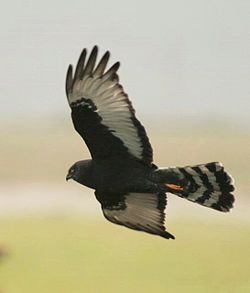 |
| Galapagos hawk | Buteo galapagoensis | 270-330 [14] | VU [14] |  [14] [14] | | 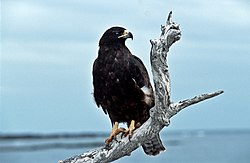 |
| Javan hawk-eagle | Nisaetus bartelsi | 300-1,200 [15] | EN [15] |  [15] [15] | |  |
| Flores hawk-eagle | Nisaetus floris | 320-1,500 [16] | EN [16] |  [16] [16] | |  |
| Ridgway's hawk | Buteo ridgwayi | 322 [17] | CR [17] |  [17] [17] | |  |
| Sanford's sea eagle | Icthyophaga sanfordi | 400-999 [18] | VU [18] |  [18] [18] | IUCN still places species in genus Haliaeetus. |  |
| Henst's goshawk | Astur henstii | 500-999 [19] | VU [19] |  [19] [19] | |  |
| Gundlach's hawk | Astur gundlachi | 500-1,000 [20] | EN [20] |  [20] [20] | IUCN assessment still places bird in genus Accipiter. |  |
| Nicobar sparrowhawk | Tachyspiza butleri | 500-2,500 [21] | VU [21] |  [21] [21] | IUCN assessment still places bird in genus Accipiter. |  |
| Southern banded snake-eagle | Circaetus fasciolatus | 670-2,000 [22] | NT [22] |  [22] [22] | |  |
| Mountain buzzard | Buteo oreophilus | 670-6,700 [23] | NT [23] |  [23] [23] | |  |
| Forest buzzard | Buteo trizonatus | 670-6,700 [24] | NT [24] |  [24] [24] | |  |
| White-throated hawk | Buteo albigula | 670-6,700 [25] | LC [25] | ? [25] | Total population is estimated to be 1,000-10,000 individuals. [25] |  |
| Rufous-tailed hawk | Buteo ventralis | 700-3,300 [26] | EN [26] |  [26] [26] | |  |
| Imitator goshawk | Tachyspiza imitator | 700-5,000 [27] | NT [27] |  [27] [27] | Best estimate for population of mature individuals is 1,001-2000. [27] IUCN assessment still places bird in genus Accipiter. |  |
| Slender-billed vulture | Gyps tenuirostris | 730-870 [28] | CR [28] |  [28] [28] | Total population is estimated to be 1,100-1,300 individuals. [28] |  |
| Crowned solitary eagle (Chaco eagle) | Buteogallus coronatus | 800-2,000 [29] | EN [29] |  [29] [29] | |  |
| Red goshawk | Erythrotriorchis radiatus | 900-1,400 [30] | EN [30] |  [30] [30] | Best estimate for population of mature individuals is 1,340. [30] | 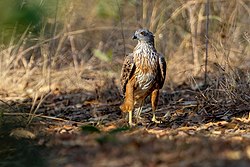 |
| North Philippine hawk-eagle (Philippine hawk-eagle) | Nisaetus philippensis | 1,000-2,000 [31] | EN [31] |  [31] [31] | |  |
| Letter-winged kite | Elanus scriptus | 1,000-2,000 [32] | NT [32] |  [32] [32] | Best estimate for population of mature individuals is 1,000-1,500. [32] |  |
| Madagascar serpent eagle | Eutriorchis astur | 1,000-2,150 [33] | EN [33] |  [33] [33] | |  |
| Pallas's fish-eagle | Haliaeetus leucoryphus | 1,000-2,499 [34] | EN [34] |  [34] [34] | |  |
| Slaty-backed goshawk (Slaty-mantled goshawk) | Tachyspiza luteoschistacea | 1,000-2,499 [35] | VU [35] |  [35] [35] | IUCN assessment gives binomial name Accipiter luteoschistaceus. | |
| Cuban black hawk | Buteogallus gundlachii | 1,000-2,499 [36] | NT [36] |  [36] [36] | | 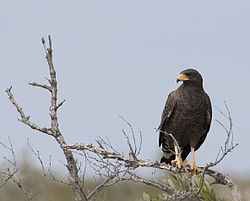 |
| Black solitary eagle (Solitary eagle) | Buteogallus solitarius | 1,000-2,499 [37] | NT [37] |  [37] [37] | |  |
| Andaman serpent-eagle | Spilornis elgini | 1,000-4,000 [38] | VU [38] |  [38] [38] | |  |
| Rufous crab-hawk | Buteogallus aequinoctialis | 1,000-9,999 [39] | NT [39] |  [39] [39] | Total population has been estimated "to be in the thousands" assuming its distribution is similar across its habitat. [39] |  |
| Spanish imperial eagle | Aquila adalberti | 1,060-1,080 [40] | VU [40] |  [40] [40] | | 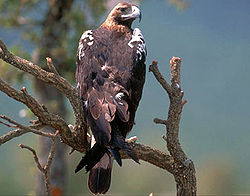 |
| Mountain hawk-eagle | Nisaetus nipalensis | 1,200-6,700 [41] | NT [41] |  [41] [41] | IOC taxonomy classifications split this species into one additional species: Legge's hawk-eagle. [1] IUCN/BirdLife International maintains this bird as a subspecies of mountain hawk-eagle. [42] |  |
| South Philippine hawk-eagle (Pinsker's hawk-eagle) | Nisaetus pinskeri | 1,300-3,600 [43] | EN [43] |  [43] [43] | |  |
| Black-and-chestnut eagle | Spizaetus isidori | 1,400-4,200 [44] | EN [44] |  [44] [44] | |  |
| Moluccan goshawk | Tachyspiza henicogrammus | 1,500-7,000 [45] | NT [45] |  [45] [45] | Total population is estimated to be 2,500-9,999 individuals. [45] IUCN assessment still places bird in genus Accipiter. |  |
| Bearded vulture (Lammergeier) | Gypaetus barbatus | 1,675-6,700 [46] | NT [46] |  [46] [46] | | 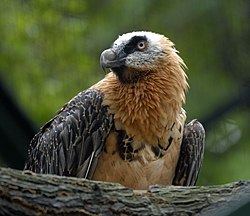 |
| Hawaiian hawk | Buteo solitarius | 1,700-2,500 [47] | NT [47] |  [47] [47] | |  |
| White-headed vulture | Trigonoceps occipitalis | 2,500-9,999 [48] | CR [48] |  [48] [48] | |  |
| Red-headed vulture | Sarcogyps calvus | 2,500-9,999 [49] | CR [49] |  [49] [49] | Total population is estimated to be 3,500-15,000 individuals. Population is currently experiencing a >99% decline over three generations. [49] |  |
| Beaudouin's snake-eagle | Circaetus beaudouini | 2,500-9,999 [50] | VU [50] |  [50] [50] | |  |
| New Britain goshawk | Tachyspiza princeps | 2,500-9,999 [51] | VU [51] |  [51] [51] | IUCN assessment still places bird in genus Accipiter. | |
| New Britain sparrowhawk | Tachyspiza brachyura | 2,500-9,999 [52] | VU [52] |  [52] [52] | IUCN assessment gives binomial name Accipiter brachyurus. | |
| Wallace's hawk-eagle | Nisaetus nanus | 2,500-9,999 [53] | VU [53] |  [53] [53] | Total population is estimated to be 3,500-15,000 individuals. [53] |  |
| Gurney's eagle | Aquila gurneyi | 2,500-9,999 [54] | NT [54] |  [54] [54] | | 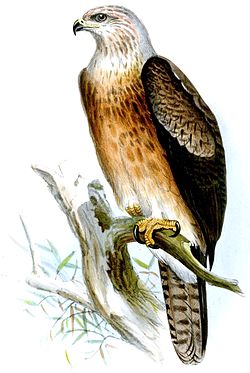 |
| Mantled hawk | Pseudastur polionotus | 2,500-9,999 [55] | NT [55] |  [55] [55] | |  |
| White-necked hawk | Buteogallus lacernulatus | 2,500-9,999 [56] | NT [56] |  [56] [56] | |  |
| Chestnut-shouldered goshawk | Erythrotriorchis buergersi | 2,500-9,999 [57] | NT [57] |  [57] [57] | | |
| Grey goshawk | Tachyspiza novaehollandiae | 2,500-9,999 [58] | LC [58] |  [58] [58] | IUCN assessment still places bird in genus Accipiter. | 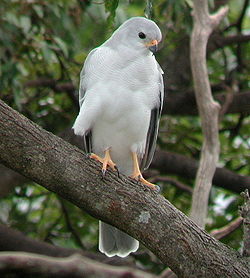 |
| Grey-backed hawk | Pseudastur occidentalis | 2,500-10,000 [59] | VU [59] |  [59] [59] | Best estimate for population of mature individuals is 2,600. [59] |  |
| Kinabalu serpent-eagle (Mountain serpent eagle) | Spilornis kinabaluensis | 2,500-19,999 [60] | NT [60] |  [60] [60] | Best estimate for population of mature individuals is 5,000-9,999. [60] |  |
| White-bellied sea-eagle | Icthyophaga leucogaster | 2,600-41,000 [61] | LC [61] |  [61] [61] | IUCN still places species in genus Haliaeetus. |  |
| Papuan eagle | Harpyopsis novaeguineae | 3,200-4,000 [62] | VU [62] |  [62] [62] | |  |
| Madagascar sparrowhawk | Accipiter madagascariensis | 3,300-6,700 [63] | NT [63] |  [63] [63] | |  |
| Steller's sea-eagle | Haliaeetus pelagicus | 3,600-4,670 [64] | VU [64] |  [64] [64] | Total population is estimated to be 4,600-7,000 individuals. [64] |  |
| Greater spotted eagle | Clanga clanga | 3,900-10,000 [65] | VU [65] |  [65] [65] | | 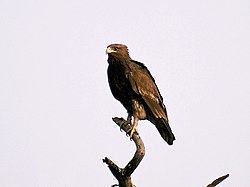 |
| White-rumped vulture | Gyps bengalensis | 4,000-6,000 [66] | CR [66] |  [66] [66] | Once described as "possibly the most abundant large bird of prey in the world", numbering millions. Catastrophic population collapse beginning in the 1990s caused by diclofenac, leading to >99% decline over three generations. [66] |  |
| White-bellied goshawk | Tachyspiza haplochroa | 5,000-9,999 [67] | NT [67] |  [67] [67] | IUCN assessment gives binomial name Accipiter haplochrous. |  |
| Indian vulture | Gyps indicus | 5,000-15,000 [68] | CR [68] |  [68] [68] | 99% population collapse over three generations, caused by diclofenac. [68] |  |
| Crowned eagle | Stephanoaetus coronatus | 5,000-50,000 [69] | NT [69] |  [69] [69] | |  |
| Black honey-buzzard | Henicopernis infuscatus | 6,000-15,000 [70] | VU [70] |  [70] [70] | | |
| Lappet-faced vulture | Torgos tracheliotos | 6,500 [71] | EN [71] |  [71] [71] | Total population is estimated to be 9,200 individuals, which is likely now an overestimate given steep declines. [71] |  |
| Andean condor | Vultur gryphus | 6,700 [72] | VU [72] |  [72] [72] | Total population is estimated to be 10,000 individuals, though this is the maximum. [72] | 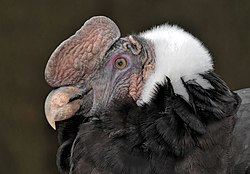 |
| Jerdon's baza | Aviceda jerdoni | 6,700 [73] | LC [73] |  [73] [73] | Total population estimated to be 10,000 individuals. [73] |  |
| Brown snake-eagle | Circaetus cinereus | 6,700-67,000 [74] | LC [74] |  [74] [74] | Total population is estimated to be 10,000-100,000 individuals. [74] |  |
| Ovambo sparrowhawk | Accipiter ovampensis | 6,700-67,000 [75] | LC [75] |  [75] [75] | |  |
| Secretarybird | Sagittarius serpentarius | 6,700-67,000 [76] | EN [76] |  [76] [76] | |  |
| Cape vulture | Gyps coprotheres | 9,600-12,800 [77] | VU [77] |  [77] [77] | |  |
| Black eagle | Ictinaetus malayensis | 10,000 [78] | LC [78] |  [78] [78] | Value provided is a 2001 estimate for total population. [78] |  |
| Martial eagle | Polemaetus bellicosus | >10,000 [79] | EN [79] |  [79] [79] | Total population is estimated to be "probably in tens of thousands." [79] |  |
| African cuckoo-hawk | Aviceda cuculoides | >10,000 [80] | LC [80] |  [80] [80] | Total population "likely to exceed 10,000 individuals, based on its large range." [80] |  |
| Pied harrier | Circus melanoleucos | >10,000 [81] | LC [81] |  [81] [81] | Value provided is the minimum estimate for total population. [81] |  |
| Upland buzzard | Buteo hemilasius | >10,000 [82] | LC [82] |  [82] [82] | Value provided is the minimum estimate for total population. [82] |  |
| Red-necked buzzard | Buteo auguralis | >10,000 [83] | LC [83] |  [83] [83] | No collected population data, but "a five-figure population is suspected based on wide distribution." [83] |  |
| Semi-collared hawk | Microspizias collaris | 10,000-19,999 [84] | LC [84] |  [84] [84] | IUCN assessment still places bird in genus Accipiter. | 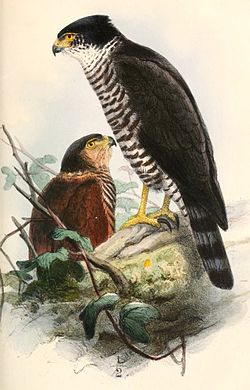 |
| Plumbeous hawk | Cryptoleucopteryx plumbea | 10,000-19,999 [85] | NT [85] |  [85] [85] | |  |
| Levant sparrowhawk | Tachyspiza brevipes | 10,000-19,999 [86] | LC [86] |  [86] [86] | IUCN assessment still places bird in genus Accipiter. |  |
| Black baza | Aviceda leuphotes | 10,000-50,000 [87] | LC [87] |  [87] [87] | |  |
| Bateleur | Terathopius ecaudatus | 10,000-99,999 [88] | EN [88] |  [88] [88] | Population is estimated to be "in the tens of thousands." [88] |  |
| Verreaux's eagle | Aquila verreauxii | 10,000-99,999 [89] | LC [89] |  [89] [89] | Values given are estimates for the total population. [89] |  |
| Swamp harrier | Circus appoximans | 10,000-99,999 [90] | LC [90] |  [90] [90] | Total population is estimated to be "in the tens of thousands." [90] |  |
| Grey-headed goshawk | Tachyspiza poliocephala | 10,000-99,999 [91] | LC [91] |  [91] [91] | Total population "is estimated to number in the tens of thousands." [91] IUCN assessment still places bird in genus Accipiter. | 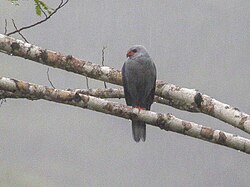 |
| Little sparrowhawk | Tachyspiza minulla | 10,000-99,999 [92] | LC [92] |  [92] [92] | Total population "is estimated to number in the tens of thousands." [92] IUCN assessment gives binomial name Accipiter minullus. |  |
| Crested goshawk | Lophospiza trivirgata | 10,000-99,999 [93] | LC [93] |  [93] [93] | Total population "is thought to number in the tens of thousands." [93] IUCN assessment still places bird in genus Accipiter. |  |
| Slate-colored hawk | Buteogallus schistaceus | 10,000-99,999 [94] | LC [94] |  [94] [94] | Total population "is estimated to number in the tens of thousands." [94] |  |
| Jackal buzzard | Buteo rufofuscus | 10,000-99,999 [95] | LC [95] |  [95] [95] | Total population "is estimated to number in the tens of thousands." [95] |  |
| Western banded snake-eagle | Circaetus cinerascens | 10,000-100,000 [96] | LC [96] |  [96] [96] | Total population is expected to lie at the lower end of the given range. [96] |  |
| Little eagle | Hieraaetus morphnoides | 10,000-100,000 [97] | LC [97] |  [97] [97] | |  |
| Egyptian vulture | Neophron percnopterus | 12,400-36,000 [98] | EN [98] |  [98] [98] | |  |
| Japanese sparrowhawk | Tachyspiza gularis | 13,400-67,000 [99] | LC [99] |  [99] [99] | IUCN assessment still places bird in genus Accipiter. | 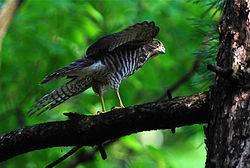 |
| Eastern imperial eagle | Aquila heliaca | 16,000-20,000 [100] | VU [100] |  [100] [100] | |  |
| Cinereous vulture | Aegypius monachus | 16,800-22,800 [101] | NT [101] |  [101] [101] | |  |
| Pallid harrier | Circus macrourus | 18,000-30,000 [102] | NT [102] |  [102] [102] | |  |
| Barred hawk | Morphnarchus princeps | 20,000-49,999 [103] | LC [103] |  [103] [103] | |  |
| Ayres's hawk-eagle | Hieraaetus ayresii | 20,000-49,999 [104] | LC [104] |  [104] [104] | |  |
| Grasshopper buzzard | Butastur rufipennis | 20,000-49,999 [105] | LC [105] |  [105] [105] | |  |
| Semiplumbeous hawk | Leucopternis semiplumbeus | 20,000-49,999 [106] | LC [106] |  [106] [106] | | 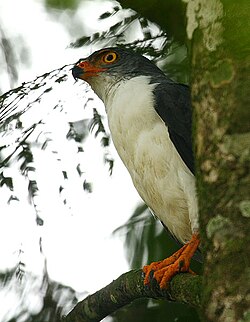 |
| Black-and-white hawk-eagle | Spizaetus melanoleucus | 20,000-49,999 [107] | LC [107] |  [107] [107] | |  |
| Bonelli's eagle | Aquila fasciata | 20,000-50,000 [108] | LC [108] |  [108] [108] | |  |
| White-tailed sea-eagle (White-tailed eagle) | Haliaeetus albicilla | 20,000-60,000 [109] | LC [109] |  [109] [109] | |  |
| Rüppell's vulture | Gyps rueppelli | 22,000 [110] | CR [110] |  [110] [110] | |  |
| Scissor-tailed kite | Chelictinia riocourii | 30,000-67,000 [111] | VU [111] |  [111] [111] | |  |
| Harris's hawk | Parabuteo unicinctus | 30,000-87,000 [112] | LC [112] | ? [112] | |  |
| Eastern marsh-harrier | Circus spilonotus | 40,000-60,000 [113] | LC [113] |  [113] [113] | |  |
| Lesser spotted eagle | Clanga pomarina | 40,000-60,000 [114] | LC [114] |  [114] [114] | | 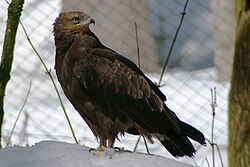 |
| Besra | Tachyspiza virgata | 40,000-400,000 [115] | LC [115] |  [115] [115] | IUCN assessment gives binomial name Accipiter virgatus. |  |
| Steppe eagle | Aquila nipalensis | 50,000-75,000 [116] | EN [116] |  [116] [116] | |  |
| Frances's sparrowhawk | Tachyspiza francesiae | 50,000-99,999 [117] | LC [117] |  [117] [117] | IUCN assessment still places bird in genus Accipiter. |  |
| Long-crested eagle | Lophaetus occipitalis | 50,000-99,999 [118] | LC [118] |  [118] [118] | Population is estimated as "likely to number in the upper tens of thousands of mature individuals." [118] |  |
| Short-toed snake-eagle | Circaetus gallicus | 50,000-99,999 [119] | LC [119] |  [119] [119] | | 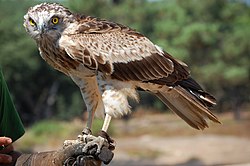 |
| African hawk-eagle | Aquila spilogaster | 50,000-499,999 [120] | LC [120] |  [120] [120] | With regard to total population, it "may be in the six-figure range; however, it is more cautious to assume it lies between the upper tens of thousands and the lower hundreds of thousands." [120] |  |
| Tiny hawk | Microspizias superciliosus | 50,000-499,999 [121] | LC [121] |  [121] [121] | IUCN assessment still places bird in genus Accipiter. |  |
| Black-collared hawk | Busarellus nigricollis | 50,000-499,999 [122] | LC [122] |  [122] [122] | |  |
| Black hawk-eagle | Spizaetus tyrannus | 50,000-499,999 [123] | LC [123] |  [123] [123] | |  |
| White hawk | Pseudastur albicollis | 50,000-499,999 [124] | LC [124] |  [124] [124] | |  |
| Ornate hawk-eagle | Spizaetus ornatus | 50,000-499,999 [125] | NT [125] |  [125] [125] | |  |
| Grey-headed kite | Leptodon cayanensis | 50,000-499,999 [126] | LC [126] |  [126] [126] | | 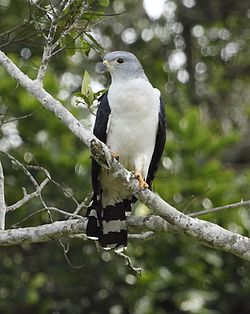 |
| Red kite | Milvus milvus | 60,000-70,000 [127] | LC [127] |  [127] [127] | |  |
| Himalayan griffon (Himalayan vulture) | Gyps himalayensis | 66,000-334,000 [128] | NT [128] |  [128] [128] | |  |
| Oriental honey-buzzard (Crested honey-buzzard) | Pernis ptilorhyncus | 66,666-666,666 [129] | LC [129] |  [129] [129] | |  |
| Brahminy kite | Haliastur indus | 67,000 [130] | LC [130] |  [130] [130] | | 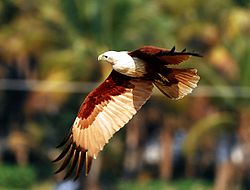 |
| Wahlberg's eagle | Hieraaetus wahlbergi | 67,000-670,000 [131] | LC [131] |  [131] [131] | |  |
| Griffon vulture (Eurasian griffon vulture) | Gyps fulvus | 80,000-900,000 [132] | LC [132] |  [132] [132] | | 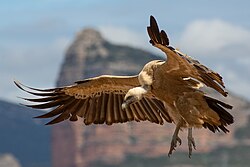 |
| Golden eagle | Aquila chrysaetos | 85,000-160,000 [133] | LC [133] |  [133] [133] | | 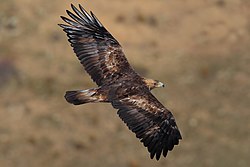 |
| Ferruginous hawk | Buteo regalis | 86,000-140,000 [134] | LC [134] |  [134] [134] | |  |
| Black-shouldered kite | Elanus axillaris | >100,000 [135] | LC [135] |  [135] [135] | Value provided is a 2001 estimate for total population. [135] |  |
| Variable goshawk | Tachyspiza hiogaster | >100,000 [136] | LC [136] |  [136] [136] | Value provided is a 2001 estimate for total population. [136] IUCN assessment still places bird in genus Accipiter. | 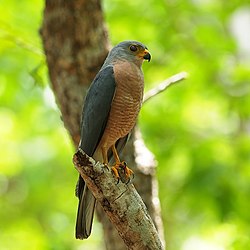 |
| Grey-faced buzzard | Butastur indicus | >100,000 [137] | LC [137] |  [137] [137] | Value provided is a 2001 estimate for total population, based on migratory bird counts. [137] | 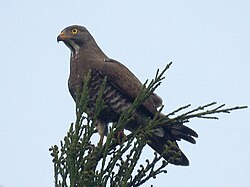 |
| Harpy eagle | Harpia harpyja | 100,000-250,000 [138] | VU [138] |  [138] [138] | |  |
| Long-legged buzzard | Buteo rufinus | 100,000-499,999 [139] | LC [139] |  [139] [139] | |  |
| Swallow-tailed kite | Elanoides forficatus | 100,000-499,999 [140] | LC [140] | ? [140] | |  |
| Tawny eagle | Aquila rapax | 100,000-499,999 [141] | VU [141] |  [141] [141] | |  |
| Osprey | Pandion haliaetus | 100,000-1,200,000 [142] | LC [142] |  [142] [142] | | 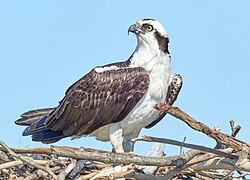 |
| Hooded vulture | Necrosyrtes monachus | 131,320 [143] | CR [143] |  [143] [143] | Maximum estimate. Total population has a maximum estimate of 197,000 individuals. [143] |  |
| Booted eagle | Hieraaetus pennatus | 150,000-195,000 [144] | LC [144] |  [144] [144] | |  |
| Hook-billed kite | Chondrohierax uncinatus | 200,000 [145] | LC [145] |  [145] [145] | |  |
| White-tailed kite | Elanus leucurus | 200,000-300,000 [146] | LC [146] |  [146] [146] | | 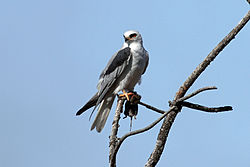 |
| Bald eagle | Haliaeetus leucocephalus | >200,000 [147] | LC [147] |  [147] [147] | Note that the U.S. Fish & Wildlife Service reports a total population of 316,000 individuals in the contiguous United States. [148] The Alaska Department of Fish & Game estimates an additional 30,000-150,000 within the state. [149] | 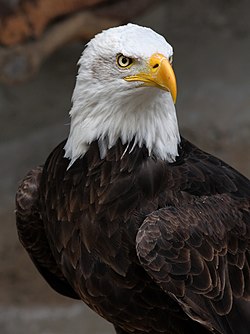 |
| Palm-nut vulture | Gypohierax angolensis | 240,000 [150] | LC [150] |  [150] [150] | Population estimate is for the total population and was made in the early 1990s; may be outdated. [150] |  |
| Chinese sparrowhawk | Tachyspiza soloensis | 268,000-667,000 [151] | LC [151] |  [151] [151] | IUCN assessment still places bird in genus Accipiter. |  |
| European honey-buzzard | Pernis apivorus | 290,000-430,000 [152] | LC [152] |  [152] [152] | |  |
| Sharp-shinned hawk | Accipiter striatus | 300,000-520,000 [153] | LC [153] |  [153] [153] | IOC taxonomy classifications split this species into three additional species: white-breasted hawk, plain-breasted hawk, and rufous-thighed hawk. [1] IUCN/BirdLife International maintains these birds are subspecies of sharp-shinned hawk. [42] |  |
| Montagu's harrier | Circus pygargus | 300,000-550,000 [154] | LC [154] |  [154] [154] | |  |
| Hen harrier | Circus cyaneus | 330,000-512,000 [155] | LC [155] |  [155] [155] | |  |
| Rough-legged buzzard (Rough-legged hawk) | Buteo lagopus | 350,000-800,000 [156] | LC [156] |  [156] [156] | |  |
| Dark chanting-goshawk | Melierax metabates | >500,000 [157] | LC [157] |  | Value provided is a minimum estimate; given its large range, "a density of one pair per 20 km2 would result in a population in the millions. Excluding immatures, the total population is still likely to number in the upper hundreds of thousands." [157] |  |
| Shikra | Tachyspiza badia | 500,000-999,999 [158] | LC [158] |  [158] [158] | IUCN assessment gives binomial name Accipiter badius. | 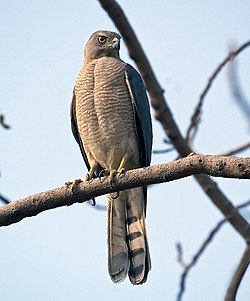 |
| Bicolored hawk | Astur bicolor | 500,000-4,999,999 [159] | LC [159] |  [159] [159] | IUCN assessment still places bird in genus Accipiter. IOC taxonomy classifications split this species into one additional species: Chilean hawk. [1] IUCN/BirdLife International maintains this bird as a subspecies of bicolored hawk. [42] | 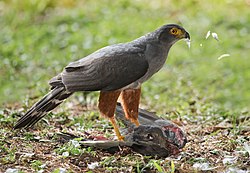 |
| Slender-billed kite | Helicolestes hamatus | 500,000-4,999,999 [160] | LC [160] |  [160] [160] | |  |
| Great black hawk | Buteogallus urubitinga | 500,000-4,999,999 [161] | LC [161] |  [161] [161] | |  |
| Pearl kite | Gampsonyx swainsonii | 500,000-4,999,999 [162] | LC [162] |  [162] [162] | |  |
| Crane hawk | Geranospiza caerulescens | 500,000-4,999,999 [163] | LC [163] |  [163] [163] | |  |
| Double-toothed kite | Harpagus bidentatus | 500,000-4,999,999 [164] | LC [164] |  [164] [164] | |  |
| Lesser yellow-headed vulture | Cathartes burrovianus | 500,000-4,999,999 [165] | LC [165] |  [165] [165] | |  |
| Plumbeous kite | Ictinia plumbea | 500,000-4,999,999 [166] | LC [166] |  [166] [166] | |  |
| Grey-lined hawk | Buteo nitidus | 500,000-4,999,999 [167] | LC [167] |  [167] [167] | |  |
| Mississippi kite | Ictinia mississippiensis | 540,000-880,000 [168] | LC [168] |  [168] [168] | |  |
| Western marsh-harrier | Circus aeruginosus | 600,000-1,100,000 [169] | LC [169] |  [169] [169] | |  |
| Northern harrier | Circus hudsonius | 730,000-920,000 [170] | LC [170] |  [170] [170] | Best estimate for number of mature individuals is 820,000. [170] |  |
| Cooper's hawk | Astur cooperii | 770,000-920,000 [171] | LC [171] |  [171] [171] | IUCN still places bird in genus Accipiter. |  |
| Swainson's hawk | Buteo swainsoni | 900,000 [172] | LC [172] |  [172] [172] | |  |
| African harrier-hawk | Polyboroides typus | < 1,000,000 [173] | LC [173] |  [173] [173] | Species has a wide range, but irregular distribution; a 2001 estimate suggests a "total population probably under one million individuals." [173] | 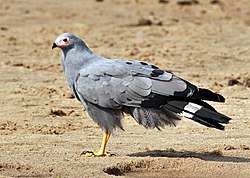 |
| Northern goshawk (Eurasian goshawk) | Astur gentilis | 1,000,000-2,499,999 [174] | LC [174] | ? [174] | IUCN assessment still places bird in genus Accipiter. IOC taxonomy classifications split this species into one additional species: American goshawk. [1] IUCN/BirdLife International maintains this bird as a subspecies of northern goshawk. [42] |  |
| Augur buzzard | Buteo augur | >1,000,000 [175] | LC [175] |  [175] [175] | Value provided is a very rough estimate. [175] |  |
| Broad-winged hawk | Buteo platypterus | 1,600,000-2,000,000 [176] | LC [176] |  [176] [176] | |  |
| Red-shouldered hawk | Buteo lineatus | 1,900,000 [177] | LC [177] |  [177] [177] | |  |
| Common black hawk | Buteogallus anthracinus | 2,000,000 [178] | LC [178] |  [178] [178] | |  |
| Zone-tailed hawk | Buteo albonotatus | 2,000,000 [179] | LC [179] |  [179] [179] | |  |
| Grey hawk | Buteo plagiatus | 2,000,000 [180] | LC [180] |  [180] [180] | | 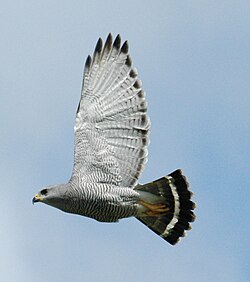 |
| Snail kite | Rostrhamus sociabilis | 2,000,000 [181] | LC [181] |  [181] [181] | | 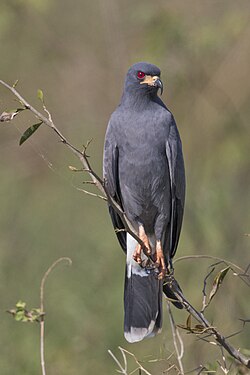 |
| White-tailed hawk | Geranoaetus albicaudatus | 2,000,000 [182] | LC [182] | ? [182] | |  |
| Eurasian sparrowhawk | Accipiter nisus | 2,000,000-3,200,000 [183] | LC [183] |  [183] [183] | |  |
| Red-tailed hawk | Buteo jamaicensis | 2,600,000-3,100,000 [184] | LC [184] |  [184] [184] | | 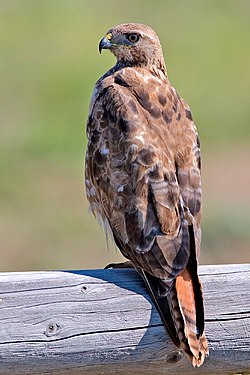 |
| Eurasian buzzard (Common buzzard) | Buteo buteo | 4,000,000 [185] | LC [185] |  [185] [185] | IOC taxonomy classifications split this species into one additional species: Cape Verde buzzard. [1] IUCN/BirdLife International maintains this bird as a subspecies of Eurasian buzzard. [42] |  |
| Black kite | Milvus migrans | 4,000,000 - 5,700,000 [186] | LC [186] |  [186] [186] | | 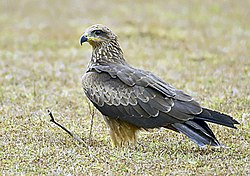 |
| Roadside hawk | Rupornis magnirostris | 5,000,000-50,000,000 [187] | LC [187] |  [187] [187] | |  |
| Savanna hawk | Buteogallus meridionalis | 5,000,000-50,000,000 [188] | LC [188] |  [188] [188] | |  |
| Short-tailed hawk | Buteo brachyurus | 5,000,000-50,000,000 [189] | LC [189] |  [189] [189] | |  |
| Turkey vulture | Cathartes aura | 28,000,000 [190] | LC [191] |  [191] [191] | No population estimates are provided by IUCN. [191] Value provided is estimate of total population from Partners in Flight. [190] |  |
| American black vulture (Black vulture) | Coragyps atratus | 50,000,000-99,999,999 [192] | LC [192] | ? [192] | |  |
|


























































































































































































